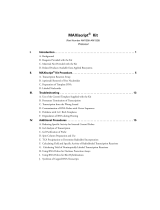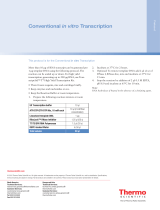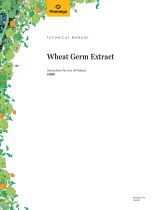Page is loading ...

Protocol
Double stranded linear DNA with blunt or 5’-protruding
ends can be used as template for in vitro transcription.
Linearized plasmid DNA, PCR products or cDNA can be
used as templates for transcription if they contain a
double-stranded RNA polymerase promoter region in the
correct orientation.
Consensus promoter sequences of different RNA
Polymerases:
T7 TAATACGACTCACTATAGGG
T3 AATTAACCCTCACTAAAGGG
SP6 ATTTAGGTGACACTATAGAA
G will be the rst base (+1) of the RNA transcript
The synthesis of sense or antisense RNA transcripts
depends on the orientation of the promoter with respect
to target sequence. The target sequence must be placed
downstream of the promoter for sense RNA and must be
inverted for antisense RNA transcription.
Plasmid Templates
Quality
Plasmid DNA quality affects transcription yield and the
integrity of synthesized RNA. The greatest transcription
yields are achieved with the highest purity plasmid
templates. Plasmids puried by common laboratory
methods can be used if the DNA is free of contaminating
RNases, SDS, EDTA, proteins, salts* and RNA. DNA
should have a A260/280 ratio of 1.8-2.0. The GeneJET™
Plasmid Miniprep Kit generates high purity plasmid DNA
suitable for transcription.
* T7 and SP6 RNA Polymerases are inhibited by ~50% at
NaCl or KCl concentrations above 150 mM and T3
RNA Polymerase – at above 250 mM.
Linearization
To produce RNA transcripts of a dened length, plasmid
DNA is linearized by restriction digestion downstream of
the insert. Restriction enzymes which generate blunt ends
or 5’-overhangs are preferred. 3’-overhangs have been
reported to generate spurious transcripts (1) and should
therefore be avoided. 3’-overhangs can be blunted by T4
DNA Polymerase prior to transcription.
Due to the high processivity of RNA polymerases, circular
plasmid templates generate long heterogeneous RNA
transcripts in higher quantities than linear templates.
Therefore, it is important to completely linearize plasmid
DNA to ensure efcient synthesis of dened length
transcripts. If complete digestion is unachievable, gel
purify the linearized DNA template band e.g. with a DNA
Gel Extraction Kit prior to transcription reactions.
DNA Template Preparation for
in vitro
Transcription
This protocol is for the
DNA Template Preparation for in vitro Transcription

North America
Technical Services:
techservice.genomics@thermofisher.com
Customer Services:
customerservice.genomics@
thermofisher.com
Tel 800 235 9880
Fax 800 292 6088
Europe and Asia
Technical Services:
techservice.emea.genomics@
thermofisher.com
Customer Services:
customerservice.emea.genomics@
thermofisher.com
thermoscientific.com
© 2012 Thermo Fisher Scientic Inc. All rights reserved. All trademarks are the property of Thermo Fisher Scientic Inc. and its subsidiaries. Specications,
terms and pricing are subject to change. Not all products are available in all countries. Please consult your local sales representative for details.
PCR Templates
PCR products can serve as templates for in vitro tran-
scription. The RNA polymerase promoter must be located
upstream of the sequence to be transcribed.
After linearization, it is recommended to purify the DNA
template by phenol/chloroform extraction:
1. Add th volume of 3 M Sodium Acetate Solution
to the DNA.
2. Mix thoroughly.
3. Extract with an equal volume of a 1:1 phenol/
chloroform mixture, and then twice with an equal
volume of chloroform. Collect the aqueous phase
and transfer to a new tube.
4. Precipitate the DNA by adding 2 volumes of ethanol.
Incubate at -20°C for at least 30 min and collect the
pellet by centrifugation.
5. Remove the supernatant and rinse the pellet with
500 µl of cold 70% ethanol.
6. Resuspend the DNA in 20 µl of DEPC-treated water.
/










